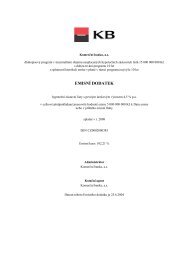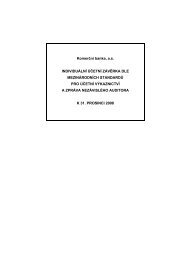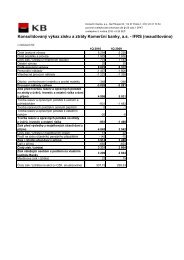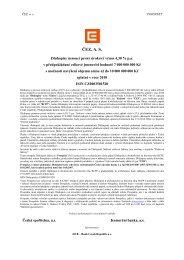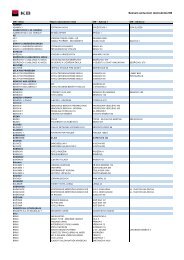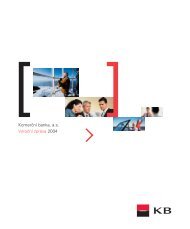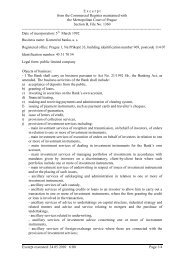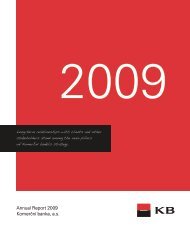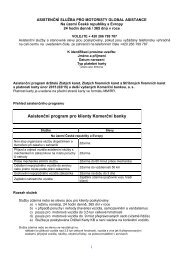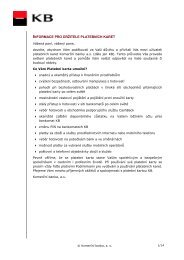KB prezent. angl - Komerční banka
KB prezent. angl - Komerční banka
KB prezent. angl - Komerční banka
Create successful ePaper yourself
Turn your PDF publications into a flip-book with our unique Google optimized e-Paper software.
156 ➔157<br />
Consolidated Financial Statements<br />
under IFRS<br />
Products traded by the Group<br />
The Group trades the following products that carry an element of market risk: loans and deposits in the interbank market, currency<br />
transactions (spots, swaps, forwards), interest rate instruments (interest rate swaps, FRAs), treasury bills and Government bonds,<br />
corporate bonds and other specific products, such as bills of exchange/bill programs, cash management for selected clients, etc.<br />
The Group does not conduct any proprietary option transactions, it only enters into back-to-back transactions with options.<br />
The Group enters into transactions with financial derivative instruments for proprietary purposes as well as on clients’ accounts.<br />
In addition, the Group uses derivative instruments to hedge positions that expose the Group to market risk.<br />
In order to hedge its own positions, the Group primarily uses interest rate swaps, FRAs and currency swaps.<br />
The Group has also entered into a number of structured financial derivative transactions for its clients which are designed to meet the<br />
clients’ hedging needs. These products are measured using internal models; market risk is eliminated by closing the position through<br />
a back-to-back deal.<br />
Financial derivative instruments are traded only on over-the-counter markets. The Group trades no stock exchange derivatives.<br />
Market risk in the Market Book<br />
In order to measure market risk inherent in the Market Book, the Group uses, inter alia, the Value at Risk concept. Value at Risk is<br />
calculated using historical simulations and represents a maximum potential loss on the portfolio over a given time period (typically<br />
one trading day) with a confidence level of 99 percent. The Group uses analyses of historical scenarios (“back testing”) to validate<br />
the correctness of Value at Risk. The actual results of the trading books are compared with the modelled value of Value at Risk and<br />
the Group assesses the number of breaches of the confidence level.<br />
The Group has also implemented daily analyses of shock scenarios (“stress testing”) of all open positions in the Market Book.<br />
The Group has defined shock scenarios for principal groups of currencies.<br />
The Global Value at Risk over the holding period of one day with a confidence level of 99 percent was EUR (583,570) and EUR<br />
(289,993) as of 31 December 2003 and 2002, respectively. The average Global Value at Risk was EUR (417,072) and EUR (381,579)<br />
for the years ended 31 December 2003 and 2002, respectively. The Value at Risk limits were determined by management of the<br />
Group for risk management.<br />
Market risk in the Structural Book<br />
The foreign exchange position is monitored on a daily basis in accordance with the CNB Regulation on capital adequacy of banks<br />
including credit and market risk. Within its Structural Book, the Group manages foreign exchange risk so as to achieve minimum risk<br />
exposures. In order to achieve this, the foreign exchange position of the Structural Book is measured on a daily basis and<br />
subsequently hedged under established rules. For the purpose of hedging foreign exchange positions within the Structural Book, the<br />
Group uses standard cross-currency instruments in the interbank market, such as cross-currency spots and forwards. Pursuant to<br />
regulatory requirements, the Group reports, on a monthly basis, on its foreign currency and Czech crown position to the Czech<br />
National Bank.<br />
Interest rate risk within the Structural Book is monitored and measured using a static gap analysis, sensitivity of interest income to<br />
a parallel shift of the yield curve, and Earnings at Risk (“EaR”) for net interest income which is monitored separately for CZK, USD<br />
and EUR, and the sum of other foreign currencies. The EaR indicator shows the maximum departure of the planned net interest<br />
income over a one year period attributable to the movements in interest rates with a 99 percent confidence level from the initial<br />
value. EaR is set using stochastic simulations of random scenarios of interest rate developments and a change in interest income<br />
relative to the initial value is established for each scenario. The calculation of EaR to net interest income involves a stress-testing<br />
approach to interest rate risk within the Structural Book.<br />
In order to hedge interest rate risk within the Structural Book the Group uses both standard derivative instruments available in the<br />
interbank market (such as FRAs and interest rate swaps) and appropriate investment in securities or selection of interest rate<br />
parameters of other assets and liabilities.25



